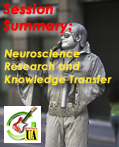![]() TechWhirl’s coverage of WritersUA 2012 is sponsored by Madcap Software. Find out more and download a trial copy of Flare 8.
TechWhirl’s coverage of WritersUA 2012 is sponsored by Madcap Software. Find out more and download a trial copy of Flare 8.
Presenter: Dr. Kevin C. Moore, Tier 1 Performance Solutions
“We can’t not learn,” says Dr. Kevin C. Moore. “Humans’ brains are hardwired to learn. However, how well we learn is entirely up to us as individuals.” Dr. Moore, the Chief Learning Officer at Tier1 Performance Solutions, believes that our working, or short-term, memory is what separates us from the other animals on earth. During his session at WritersUA, Dr. Moore showed how recent research in neuroscience can apply to user assistance because some of it focuses on how knowledge transfer takes between parties. Specifically, humans’ brains create schemas which we use to solve problems. Fear and even physiological discomfort can occur when we must change the schema we use, but neuroscience can help us mitigate these reactions.
The Role of Schemas in Knowledge Transfer
A schema is a way that the brain codes and stores information. Strategies we use to successfully interact with the world around us are one type of schema. We we invoke different or unexpected schemas than we would normally use, we call that creativity. Schemas that our brains repeatedly pull forward become more and more powerful in our minds.
Fear of Change
The brain is a dynamic organ and can be remapped. Depending on how people react to change, a lot of fear can be invoked when a powerful schema must be remapped (via the part of the brain known as the amygdala). Even so, changing a powerful schema can be quite difficult! How can we best remap a powerful schema? Interrupt it, altering it just a bit at a time.
Organizational change is unexpectedly difficult because it provokes sensations of physiological discomfort. Connection and persuasion doesn’t sufficiently engage people who have these feelings, but the act of paying attention creates physical and chemical changes in the brain. Color-coding is an excellent strategy to provoke attendance. It triggers the brain to pay attention.
Putting it All Together in Building User Assistance
Understanding the brain and its schemas can help us understand our users and their expectations. “It’s amazing how different [peoples’ brains and eyes] are, even during a shared experience,” says Dr. Moore. As time goes by, those experiences differ more and more because peoples’ perceptions differ. It’s important for tech writers to observe users closely in order to gather and use information about the ways they experience a product or service.
Ask questions! If you’re responsible for developing user assistance, you want to know: What are your users thinking when they take an action? What do they think about the changes that are being made? What is their background? People’s preconceptions about an experience often have a significant impact on what they perceive of that experience.
Dr. Kevin Moore’s Eight Steps to Using Neuroscience to Effect Change
- Establish a sense of urgency, both in a group and individually
- Form a powerful guiding coalition for your project
- Create a vision at every level
- Communicate that vision, remembering the amygdala’s influence
- Empower others to take action
- Plan for and create short-term wins (reward response)
- Realize that more change will be produced
- Institutionalize these new approaches and leverage your key adopters
Dr. Kevin C. Moore received his doctorate in Adult Learning from the University of Kentucky. He can be found on Twitter @Dr_Kev_TiER1.
